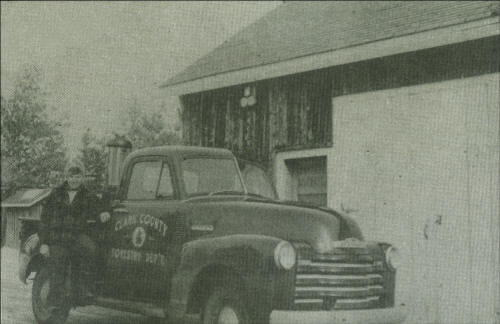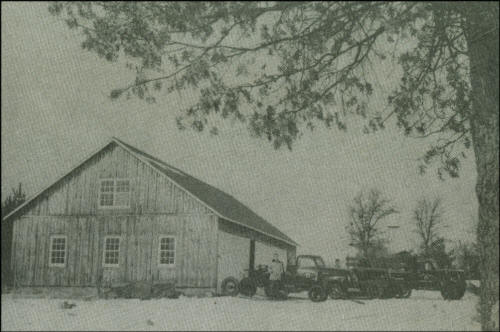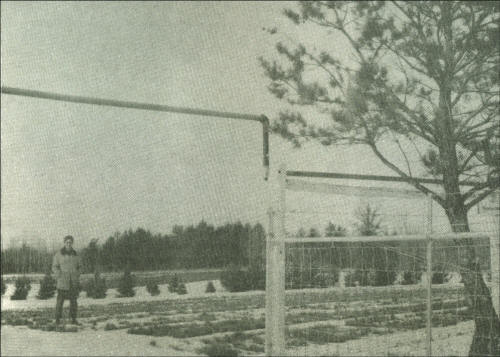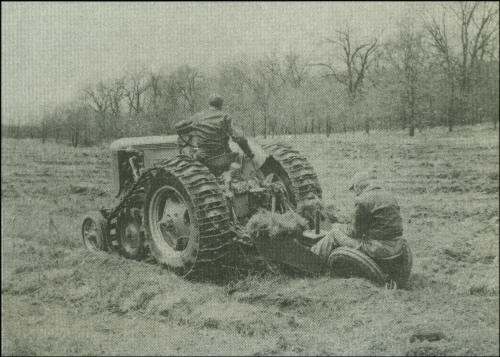|
|
 |
Clark County Press, Neillsville, WI April 26, 1995, Page 32 Transcribed by Dolores (Mohr) Kenyon. Index of "Oldies" Articles
|
|
|
 |
Clark County Press, Neillsville, WI April 26, 1995, Page 32 Transcribed by Dolores (Mohr) Kenyon. Index of "Oldies" Articles
|
Good Old Days
By Dee Zimmerman
April 23-29, 1995, has been designated as Forest Appreciation Week. Clark County ranks sixth largest in the state in the amount of forestry land. Those of us who live here can appreciate the foresight which was implemented years ago in restoration of the forest land, in the western part of the county, land meant for growing trees. Through the continued efforts of the Clark county Forestry Dept. the program has been successful and thriving.
The following information was released by the Dept. of Natural Resources in reference to the history of the forestry program in Clark County.
History and Forests Rich in Clark County
By Pat Murphy, Forestry Staff Specialist, DNR, Eau Claire
NEILLSVILLE – The face of Clark County Forest has changed greatly since the historic 1930s. During that era, industry was based on the harvest and transportation of timber economic resource. Over time the hardships of farming and poor soil caused much of this land to become tax delinquent. In1934 the County Board passed the County Forest with little regard for the future. Mark Heil, Clark County Forest administrator, explained after depletion of the timber the land was intermittently farmed and burned. Subsequently agriculture replaced timber as the county’s major Ordinance removing these acres from the tax roll, placing them in a statewide County Forest Crop law program. By 1937, 120,000 acres had been designated as part of the Clark County Forest.
Along with the natural regeneration which soon developed, the Civilian Conservation Corps (CCC) planted trees in the forest. While removal of the Christmas trees from these plantations generated most of the forest revenues in the early 1950s, state aid payments supplied a majority of the operating capital. However, from the 1950s to the 1980s the income from the county forest increased three-fold.
In the mid 1960s, a comprehensive land use plan, known as the County Forest 10-Year Plan, was formulated. It established land use policies, development strategies, fiscal guidelines and plans for managing timber, water and wildlife in the forest. The current 10-Year Plan which expires at the end of this year is being updated to establish benchmarks, through the year 2005. Heil said a newly-formed citizen advisory committee is contributing recommendations to the forestry committee for inclusion into the final document. The advisory group consists of people with interests in motorized sports, non-motorized sports, logging, farming and environmental preservation. Heil said the proposed 10 Year Plan will be available for future public comment.
Today the forest influences the local economy and provides a recreational retreat for many people. The Clark County Forest, the sixth largest in the state, covers more than 132,000 acres. Improvements in the forestry program during the last three decades can be attributed to long range planning and stewardship of the resource. Heil said in 1994 the gross timber sale receipts contributed $687,942 toward the county forestry and parks operating budget. An additional $84,000 in state aid was received as a direct result of the forest county. These revenues, combined with camping receipts and other user fees, fund one of the premier county recreational programs in the state. The forestry and parks program has been virtually self supporting requiring minimal county levee, fro a number of years.
The county forest has six campgrounds, 70 miles of snowmobile trails, 80 miles of ATV trails, boat landings, 10 day-use parks, a downhill ski facility, swimming beaches and picnic areas. Hunters find the county forest a habitat for deer and grouse, silent sport users find 24 miles of cross country skiing trails, bird watching and 45 miles of hiking trails. Travelers along State Hwy. 10 can view selective timber cuts which off scenic pleasures.
The county staff of 11 employees, including two professional foresters, conducts daily operations of the Forest and Parks program. The DNR provides the technical support with three foresters and a wildlife manager.
Heil hopes area residents recognize and appreciate the value of the Clark County Forest, but don’t take it for granted. “It’s an investment with a future.”
The Clark County Forest also boosts the local economy. Loggers and wood transporters work in the woods to earn their living, but they aren’t the only businesses depending on the forest. Equipment dealers, repair workers, bankers, restaurant operators and gas station owners all thrive because of the county forest.
Aspen is the primary tree species found in the Clark County Forest. Some 63,000 acres or half of the total acreage of the forest is aspen. Much of the aspen was past its prime 15 years ago. “Many of these sites were in jeopardy of being lost to natural mortality. They’d been taken over by brush,” said Don Streiff, DNR forester at Neillsville who works in Clark County.
Working together, county and state foresters made a major effort to harvest the aspen before it decayed in the woods. A group marking camp, known as “Popple Camp,” was inaugurated in 1978 to efficiently plan timber sales. “Popple Camp” has become a tradition, and for one week each fall a team of 10-15 foresters converges on the county forest to help with the massive workload.
“Our initial goal was to deal with the aspen and to get it to market,” Streiff said. There are still many acres of aspen timber sales waiting to be sold. Dick Chose, who haws worked on the forest for 25 years said, “We’ve come a long way.” The aspen harvests improve the long-term health of the forest and enhance age diversity critical for wildlife. The size of the deer herd in Clark County can be directly attributed to forest management activities.
Few may notice the annual growth or decline of the forest; as a natural, gradual process it seems unperceivable. Quite the opposite is true of timber harvests. Even when the harvest areas are designed to enhance aesthetic values and to improve the health of the forest, no one can argue that the change is abrupt and conspicuous.
In the early 1980s people expressed concern about the size and general appearance of the cut-over areas created as over-mature aspen was harvested. The county’s forestry committee responded and began incorporating “leave zones” into timber sale layouts. These islands enrich biological diversity and aesthetic value. A policy of dispersing sales throughout the county rather than concentrating them in one area also was started.
Streiff said that in recent years the emphasis of Popple Camp has shifted to marking oak sites. Both Streiff and Heil agreed the oak resource is a “gemstone in the rough.” In general, the oak of the county forest are young and respond well to periodic thinning. Individual trees with the greatest potential are retained while trees with poor growth characteristics or less desirable species are removed. This provides more growing space for the remaining high quality oak. The real value to the county will occur in about 25-30 years. Heil said the forest will produce a continual supply of high quality, valuable oak.
The richness of the Clark County Forest is rooted in its history. It’s a gift left by early legislators and county officials who had the foresight to establish the Clark County Forest.
Perhaps the true credit though lies with the land managers who followed. As pioneers in their own right, their task has been to implement plans focusing on the forest’s future and the needs of generations yet to come.
The 1995 timber harvest types are 52 percent aspen, 16 percent oak, 15 percent non-forest, 12 percent pine and 5 percent other timber.
 |
A 1953 photo of Art Schroeder with the Forestry pickup truck (which was probably painted green as most Chevy trucks were in that decade) in front of the county storage shed.
 |
A line-up of the equipment and department’s director by the garage/storage building at the Clark County Forestry’s Nursery, west of Neillsville, along County Trunk “B.” (These photos were all taken in 1953)
 |
The Clark County Forestry Nursery plots: growing seedlings in preparation for future transplanting with E. Ferber, the director, standing in the foreground.
 |
Pine saplings, in the process of being transplanted by two men, a Case tractor and tree planter, as was the means of getting the job done on a plot of county land.
(Photos courtesy of the Clark County Forestry Dept)
|
© Every submission is protected by the Digital Millennium Copyright Act of 1998.
Show your appreciation of this freely provided information by not copying it to any other site without our permission.
Become a Clark County History Buff
|
|
A site created and
maintained by the Clark County History Buffs
Webmasters: Leon Konieczny, Tanya Paschke, Janet & Stan Schwarze, James W. Sternitzky,
|